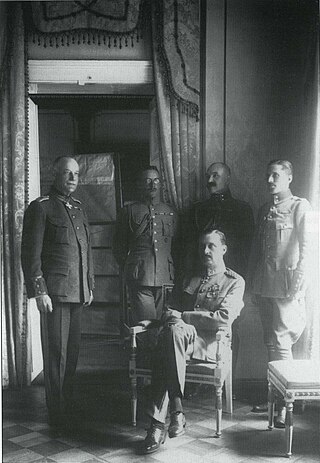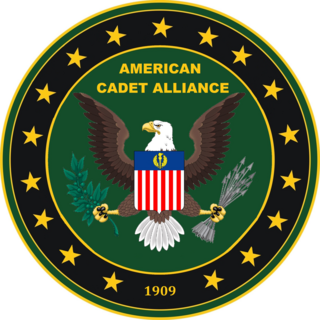A company is a military unit, typically consisting of 100–250 soldiers and usually commanded by a major or a captain. Most companies are formed of three to seven platoons, although the exact number may vary by country, unit type, and structure.

Military ranks are a system of hierarchical relationships, within armed forces, police, intelligence agencies or other institutions organized along military lines. The military rank system defines dominance, authority, and responsibility in a military hierarchy. It incorporates the principles of exercising power and authority into the military chain of command—the succession of commanders superior to subordinates through which command is exercised. The military chain of command constructs an important component for organized collective action.

A non-commissioned officer (NCO) is a military officer who does not hold a commission. Non-commissioned officers usually earn their position of authority by promotion through the enlisted ranks. In contrast, commissioned officers usually enter directly from a military academy, officer training corps (OTC) or reserve officer training corps (ROTC), or officer candidate school (OCS) or officer training school (OTS), after receiving a post-secondary degree.
Sergeant is a rank in use by the armed forces of many countries. It is also a police rank in some police services. The alternative spelling, serjeant, is used in The Rifles and other units that draw their heritage from the British light infantry. Its origin is the Latin serviens, 'one who serves', through the Old French term serjant.
Corporal is a military rank in use by the armed forces of many countries. It is also a police rank in some police services. The rank is usually the lowest ranking non-commissioned officer. In some militaries, the rank of corporal nominally corresponds to commanding a section or squad of soldiers.
Staff sergeant is a rank of non-commissioned officer used in the armed forces of many countries. It is also a police rank in some police services.
A master sergeant is the military rank for a senior non-commissioned officer in the armed forces of some countries.

Adjutant is a military appointment given to an officer who assists the commanding officer with unit administration, mostly the management of human resources in an army unit. The term adjudant is used in French-speaking armed forces as a non-commissioned officer rank similar to a staff sergeant or warrant officer but is not equivalent to the role or appointment of an adjutant.

Colour sergeant is a rank of non-commissioned officer found in several armies and marine corps.

The commanding officer (CO) or commander, or sometimes, if the incumbent is a general officer, commanding general (CG) or general officer commanding (GOC), is the officer in command of a military unit. The commanding officer has ultimate authority over the unit, and is usually given wide latitude to run the unit as they see fit, within the bounds of military law. In this respect, commanding officers have significant responsibilities, duties, and powers.

Quartermaster is a military term, the meaning of which depends on the country and service. In land armies, a quartermaster is generally a relatively senior soldier who supervises stores or barracks and distributes supplies and provisions. In many navies, a quartermaster is an officer with particular responsibility for steering and signals. The seaman is a non-commissioned officer rank; in some others, it is not a rank but a role related to navigation.

The American Cadet Alliance (ACA), formerly the United States Army Cadet Corps (USAC) was founded under the name "Colonel Cody's Boy Scouts" by Captain James H. C. Smyth at the First Presbyterian Church, Manhattan, New York in 1909. The ACA is the oldest nationwide Cadet program in the United States. It is the National Cadet Program branch of the American Military Cadet Corps (AMCC), its parent organization. ACA and American Military Cadet Corps is an Independent National Cadet Program and therefore is not a governmental agency, and is not an official entity of the United States Army.
The Military ranks of Finland are the military insignia used by the Finnish Defence Forces. The ranks incorporates features from Swedish, German, and Russian armed forces. In addition, the system has some typically Finnish characteristics that are mostly due to the personnel structure of the Finnish Defence Forces. The ranks have official names in Finnish and Swedish languages and official English translations. The Swedish forms are used in all Swedish-languages communications in Finland, e.g. in Swedish-speaking units of Finnish Defence Force. The system of ranks in the Swedish Armed Forces is slightly different.

The Order of Saint George Medallion is the top award given to members of the Army's mounted force by the United States Armor Association of the United States Army. The award is issued as a black, bronze, silver, or gold medallion, depending on the recipient's eligibility. As of June 2017, a total of 76 Gold OSGs and 4 Gold NPAs had been awarded, and a total of just over 10,000 medallions of all types.
In many militaries, a platoon sergeant is the senior enlisted member of a platoon, who advises and supports the platoon's commanding officer in leading the unit.
First sergeant is typically a senior non-commissioned officer rank, used in many countries.
Willamette Leadership Academy (WLA) is a public charter military academy in Lane County, Oregon, United States. WLA prepares students to become leaders and to live fulfilled lives as respectful and responsible citizens.

The South Carolina Corps of Cadets is the military component of the student body at The Citadel in Charleston, South Carolina. The Corps of Cadets is the only residential, full-time undergraduate program at The Citadel, focusing on educating the "whole person."
Members of Civil Air Patrol are assigned various ranks, the titles and insignia of which are based on those used by the United States Air Force. Each grade and insignia corresponds to an equivalent United States Air Force enlisted rank insignia and an equivalent officer rank insignia.










